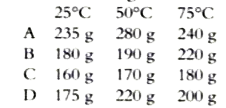Amount of solutes A,B and C in 500 g of water at 30∘C,60∘C,100∘C in their saturated solutions are given below.
30∘C60∘C100∘CA140g135g131gB160g175g182gC152g170g161g
When the hot saturated solutions of A, B and C are cooled slowly, identify the order in which they crystallize out of a solution. Give reason in support of your answer.
To determine the order in which the solutes A, B, and C crystallize out of a hot saturated solution when cooled, we need to analyze their solubility at different temperatures. The solubility data provided is as follows:
- At 30°C:
- A: 140 g
- B: 160 g
- C: 152 g
- At 60°C:
- A: 135 g
- B: 175 g
- C: 170 g
- At 100°C:
- A: 131 g
- B: 182 g
- C: 161 g
1. Understand Saturated Solutions: A saturated solution is one where no more solute can dissolve in the solvent at a given temperature. The amount of solute that can dissolve decreases as the temperature decreases.
2. Identify Solubility Trends:
- At 30°C, B has the highest solubility (160 g), followed by C (152 g), and A has the lowest solubility (140 g).
- At 60°C, B again has the highest solubility (175 g), followed by C (170 g), and A (135 g).
- At 100°C, B still has the highest solubility (182 g), followed by C (161 g), and A (131 g).
3. Determine Crystallization Order: When the hot saturated solutions cool down, the solutes will start to crystallize out in the order of their solubility:
- The solute with the lowest solubility at the cooling temperature will crystallize first.
- Since B has the highest solubility at all temperatures, it will remain dissolved the longest and will crystallize last.
- A has the lowest solubility at all temperatures, meaning it will crystallize first.
4. Final Order of Crystallization:
- First: A (lowest solubility)
- Second: C (middle solubility)
- Last: B (highest solubility)
Conclusion:
The order in which the solutes crystallize out of the solution when cooled is:
1. A
2. C
3. B
- A: 140 g
- B: 160 g
- C: 152 g
- At 60°C:
- A: 135 g
- B: 175 g
- C: 170 g
- At 100°C:
- A: 131 g
- B: 182 g
- C: 161 g
- At 30°C, B has the highest solubility (160 g), followed by C (152 g), and A has the lowest solubility (140 g).
- At 60°C, B again has the highest solubility (175 g), followed by C (170 g), and A (135 g).
- At 100°C, B still has the highest solubility (182 g), followed by C (161 g), and A (131 g).
- The solute with the lowest solubility at the cooling temperature will crystallize first.
- Since B has the highest solubility at all temperatures, it will remain dissolved the longest and will crystallize last.
- A has the lowest solubility at all temperatures, meaning it will crystallize first.
- First: A (lowest solubility)
- Second: C (middle solubility)
- Last: B (highest solubility)
The order in which the solutes crystallize out of the solution when cooled is:
1. A
2. C
3. B
Topper's Solved these Questions
- BOOK - PEARSON IIT JEE FOUNDATIONCHAPTER - WATER, SOLUTION, SOLUBILITY AND HYDROGENEXERCISE - Concept Application Level-310videos
WATER, SOLUTION, SOLUBILITY AND HYDROGEN
- BOOK - PEARSON IIT JEE FOUNDATIONCHAPTER - WATER, SOLUTION, SOLUBILITY AND HYDROGENEXERCISE - EXAMPLES4videos
WATER, SOLUTION, SOLUBILITY AND HYDROGEN
- BOOK - PEARSON IIT JEE FOUNDATIONCHAPTER - WATER, SOLUTION, SOLUBILITY AND HYDROGENEXERCISE - Concept Application Level-142videos
WATER, SOLUTION, SOLUBILITY AND HYDROGEN
- BOOK - PEARSON IIT JEE FOUNDATIONCHAPTER - SYNTHETIC FIBRES AND PLASTICS EXERCISE - COMPETITION CORNER (Choose the correct option)53videos
SYNTHETIC FIBRES AND PLASTICS
Similar Questions
Amount of solutes A,B and C in 500 g of water at 30∘C,60∘C,100∘C in their saturated solutions are given below.
30∘C60∘C100∘CA140g135g131gB160g175g182gC152g170g161g
When the hot saturated solutions of A, B and C are cooled slowly, identify the order in which they crystallize out of a solution. Give reason in support of your answer.View SolutionWhen 100 g of a saturated solution is evaporated at 50∘C, 50 g of solid is left over. Find the solubility of the substance at 50∘C.
View Solution
Knowledge Check
- Question 1 - Select One or More
Amount of solutes A,B,C,D and E in 1500 g of water at 25∘C , 50∘C and 75∘C in their saturated solutions are given below
25∘C50∘C75∘CA235g280g240gB180g190g220gC160g170g180gD175g220g200g
Arrange the solutes in the increasing order of the amount of solutes that crystallises out by cooling from 75∘C to 25∘CAABDCBACDBCCABDDACBD - Question 2 - Select One
80 g of water at 30∘C is mixed with 50 g of water at 60∘C, final temperature of mixture will be
A30 gB80 gC1600 gD150 g - Question 3 - Select One
Amount of solutes A, B, C, D and E in 1500 g of water at 25°C, 50°C and 75°C in their saturated solutions are given below:

Arrange the solutes in the increasing order of the amount of solutes that crystallizes out by cooling from 75°C to 25°C:AABDCBACDBCCABDDACBD
5 g of sodium chloride are dissolved 100 g of water to form a solution. Is this solution saturated in nature ?
View Solution4 g of a solute are dissolved in 40 g of water to form a saturated solution at 25∘C. Calculate the solubility of the solute.
View Solutionthe solubility of ammonium chloride in water at various temperature is given below :
temperature :10∘C20∘C40∘C60∘C80∘Csolubility:24g37g41g55g66g
what mass of ammonium chloride would be needed to make a saturated solution of ammonium chloride in fifty grams of water at 40∘C?View SolutionIf 3g of glucose (molecular mass 180) is dissolved in 60g of water at 15∘C, then the osmotic pressure of this solution will be :
View SolutionAt 100∘C the vapour pressure of a solution of 6.5g of an solute in 100g water is 732mm.If Kb=0.52, the boiling point of this solution will be :
View Solution

